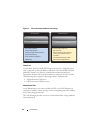
26 Introduction
PowerVault MD Storage
The controllers connect to the PowerVault MD iSCSI storage array, which is a
RAID subsystem. RAID storage subsystems are designed to eliminate single
points of failure. Each active component in the storage subsystem is
redundant and hot-swappable. The solution supports typical RAID
configurations including RAID 0, RAID 1, RAID 5, RAID 6, and RAID 10.
BPS
The BPS provides continuous power to the controllers. Each controller
receives its power from a dedicated BPS and from the power grid. The
controllers regularly monitor the BPS battery status, which requires the BPS
to maintain a minimum level of power for normal operation. The BPS has
sufficient battery power to allow the controllers to safely shut down.
The BPS enables the controllers to use the cache as NVRAM. The BPS
provides the clustered solution enough time to write all the data from the
cache to the disk if the controller experiences a loss of power.
NOTE: You can view the BPS events on the NAS Manager.
SAN Network
The SAN network is a critical part of the PowerVault NX3500 solution. The
controller pair that resides on the SAN network communicates to the storage
subsystem using the iSCSI protocol. The PowerVault NX3500 communicates
on the SANa and SANb networks, rendering a high availability (HA) design.
Internal Network
The PowerVault NX3500 solution requires an internal network for peer-to-
peer data transfer and management. To achieve complete data distribution
and to maintain HA, each controller must have access to its peer controller.
The internal network achieves this goal.
The internal network is classified into internal network A and internal network B.
NOTE: Ensure that the IP addresses you assign to internal network A and internal
network B are from a private IP space and do not conflict with other subnets on
your network.


















